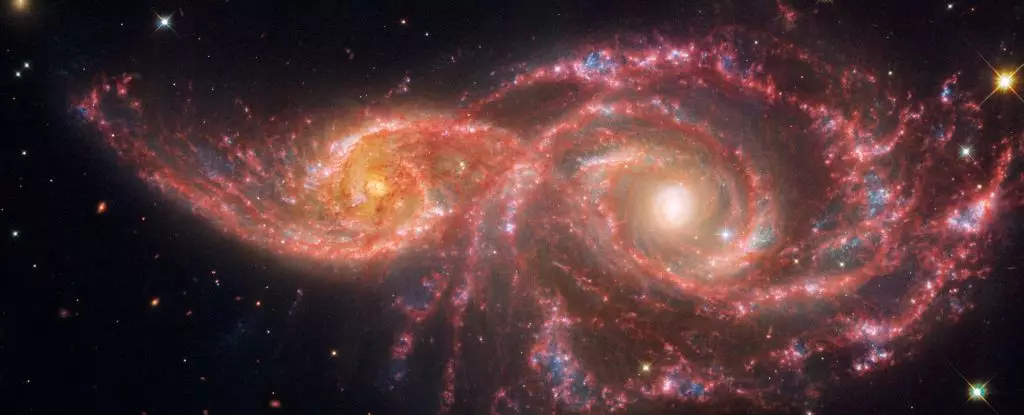The profound words of Friedrich Nietzsche, “If you gaze for long into an abyss, the abyss gazes also into you,” resonate with remarkable clarity as we explore the depths of our universe. This age-old philosophical contemplation has found new life in the context of contemporary astronomical discoveries. As we peer into the depths of space, specifically an extraordinary image captured from 80 million light-years away, we find ourselves not merely looking into the void, but instead encountering a cosmic spectacle: two galaxies, NGC 2207 and IC 2163, caught in the throes of a spectacular collision.
Rather than ethereal voids, the images reveal what appear to be ominously gazing eyes—an artistic interpretation that plays on humanity’s tendency to anthropomorphize celestial phenomena. The merging of these galaxies creates a narrative of cosmic intimacy, an eternal dance shaped by the gravitational forces at play, illuminating the paradox of our existence in a vast universe filled with unfathomable wonders and dangers.
The merger of galaxies is a captivating and intricate process, extending over eons—certainly not a cataclysmic explosion, but rather, a celestial choreography. NGC 2207 and IC 2163 have had a history of interactions, having previously brushed against one another ages ago. Their current orbital dance is just a chapter in a longer saga, as they gradually spiral closer, influenced by their mutual gravitational attraction. The progression of their merger, while still far from reaching a final celestial union, provides a real-time glimpse of the transformative processes that govern galactic evolution.
During these encounters, galaxies are not merely passive participants. As they manipulate one another’s structures, they instigate bursts of star formation. The interplay between their gaseous components generates shockwaves that compress interstellar cloud material, resulting in the birth of trillions of stars. This is an astonishing contrast to our own Milky Way, which exhibits a surprisingly low rate of star formation. In contrast, the combined artistry of NGC 2207 and IC 2163 thrives, producing stellar nurseries at a prolific pace, birthing masses equal to dozens of Suns each year.
The cosmos is a theater of creation and annihilation. In regions of active star formation, the birth of massive stars sets the stage for a cycle of life and death that reverberates through space. The lifespan of these newly formed stars is fleeting, often concluding with spectacular supernova explosions that can outshine entire galaxies. These cataclysmic events serve not only as the end of a star’s life but also as catalysts for new star formation, creating ripples in the surrounding gas and dust that perpetuate the cycle.
This phenomenon of birth and destruction enriches the interstellar medium, contributing to a tapestry of dust that can be beautifully visualized by space telescopes. The Hubble Space Telescope, with its capabilities to capture ultraviolet light, reveals the vibrant blue hues of newly formed stars that emanate from these stellar nurseries. Conversely, the James Webb Space Telescope (JWST) adeptly showcases mid-infrared images that bring forth the hidden filaments of dust scattered throughout the merging galaxies. It is through these contrasting images that a profound understanding of the cosmos emerges.
As we contemplate the eternal dance of NGC 2207 and IC 2163, we find ourselves reflecting on our insignificance within the enormity of the universe. Nietzsche’s philosophical musings gain new significance as we allow ourselves to be drawn into the complexity of cosmic existence. The grandeur of merging galaxies serves as a poignant reminder of the forces at play far beyond our earthly concerns. Our gaping at this spectacle speaks not only to our curiosity but also to an innate yearning to seek understanding in the abyss of the unknown.
Perhaps, then, we might amend Nietzsche’s assertion: gazing into the cosmic abyss allows us to glean insights not just into ourselves but into the mesmerizing, alien mechanics that have governed the universe for billions of years. In this light, the dance of these galaxies is not simply an astronomical event but a compelling and humbling reminder of the intricate tapestry of existence, where creation and destruction are eternally intertwined, inviting us to explore the unfathomable depths of our universe with awe and reverence.

